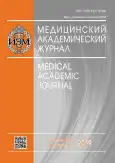ДЕЙСТВИЕ ТИМОЗИНА β4 НА ФУНКЦИОНАЛЬНУЮ АКТИВНОСТЬ КОМПОНЕНТОВ ИММУННОЙ И НЕРВНОЙ СИСТЕМ
- Авторы: Иванова ВП1
-
Учреждения:
- ФГБУН «Институт эволюционной физиологии и биохимии им. И.М. Сеченова РАН»
- Выпуск: Том 19, № 1S (2019)
- Страницы: 164-166
- Раздел: Статьи
- Статья опубликована: 15.12.2019
- URL: https://journals.eco-vector.com/MAJ/article/view/19380
- ID: 19380
Цитировать
Полный текст
Аннотация
В работе суммированы данные о свойствах тимозина β4, консервативного многофункционального полипептида млекопитающих. Внимание акцентируется на регуляторных свойствах тимозина β4 в отношении компонентов иммунной и нервной систем. В обеих системах тимозин β4 обнаружен в клетках различного типа как стационарных, так и подвижных. Кроме внутриклеточной локализации тимозин β4 также обнаружен во внеклеточных средах. Существует устойчивое мнение, что внутриклеточная активность тимозина β4 определяется его способностью регулировать полимеризацию актина посредством секвестирования G-актина. Вместе с тем, до сих пор не установлены молекулярные механизмы действия внеклеточного тимозина β4 на функции клеток. Обсуждается также вопрос о структурно-функциональной организации тимозина β4. Тимозин β4 можно рассматривать в качестве перспективного лекарственного препарата для лечения заболеваний, связанных с нарушениями иммунного и неврологического статуса больных.
Ключевые слова
Полный текст
Список литературы
- Abiko T, Sekino H. Synthesis of six common amino acid sequence fragments of thymosin β4, β8 and β9 and determination of their effects on the low E-rosette forming cells of lupus nephritis patients. Chem. Pharm. Bull. 1984;32(1):228-236.
- Huff T, et al. β-Thymosins, small acidic peptides with multiple functions. Int. J. Biochem. Cell Biol. 2001;33(3):205-220.
- Ivanova VP, et al. The effect of protein synthetic fragments on the humoral immune response. Ukr. Biokhim Zh. 1990;62(5):83-86.
- Ivanova VP, et al. The role of thymosin β4 fragment on activation of phagocytic cells. In: Molecular mechanisms of adaptations. Makhachkala: IPC DSU; 2008. P. 97-100.
- Morris DC, et al. Treatment of neurological injury with thymosin β4. Ann. N.Y. Acad. Sci. 2012;1269(1):110-116.
- Safer D. The interaction of actin with thymosin β4. J. Muscle Res. Cell Motil. 1992;13(3):269-271.
- Sosne G, et al. Biological activities of thymosin β4 defined by active sites in short peptide sequences. The FASEB J. 2010;24 (7):2144-2151.
Дополнительные файлы







